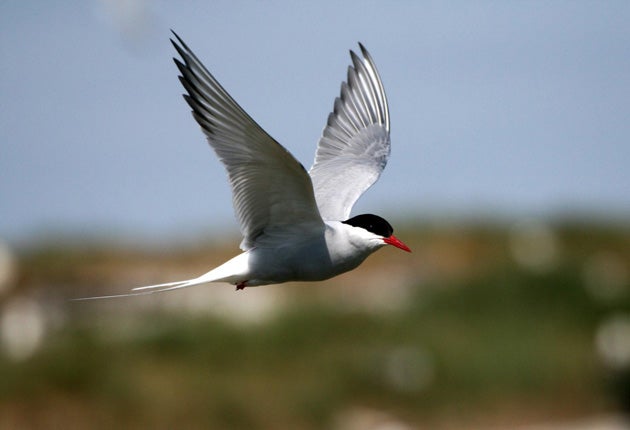Thirty years of migration – a million miles on the wing

From now on it will be known as the million-mile bird: an Arctic tern which has been migrating between northern England and the Antarctic every year for the last three decades.
Wardens on the Farne Islands off Northumberland have rediscovered the bird, which they first ringed as a chick in 1980, and which is still returning to the islands' tern colony to breed.
As Arctic terns make an extraordinary and immense journey every year – the longest migration of any bird – travelling from breeding grounds as far north as the Arctic circle to over-winter in the Antarctic, the Farne Islands individual will have covered at least 600,000 miles in its 30 years of journeying, more than the distance to the Moon and back.
But it may well have covered far more, as Arctic terns can travel as much as 44,000 miles on their migration by flying in a huge "s" shape, following prevailing winds to conserve energy.
"This bird will have flown close to one million miles, raised any number of chicks, survived predators and storms and still looks in brilliant shape," said John Walton, the National Trust property manager for the islands and the same man who ringed the bird in 1980. Mr Walton said the discovery of the tern, which is tagged with the code CE60645, was "remarkable", as only one in 50 birds which are ringed are subsequently caught again.
"Back in 1980, I was in my second year as a seasonal warden, and part of my job was ringing tern chicks," he said. "When I put ring number CE60645 on to the chick's leg and recorded it in the log, I thought no more of it. It was one of hundreds that would make the perilous journey down to the Antarctic that winter."
Around 2,200 pairs of Arctic terns spent the summer months on the Farne Islands this year, where they lay eggs on the ground and rear chicks on small fish such as sandeels. When the news broke that the 30-year-old bird had been discovered, caught and ringed on Inner Farne, Mr Walton said he was "out like a shot" to see how the tern had fared.
Ringed on 28 June 1980 when it was just a few days old, the bird is the UK's oldest known Arctic tern, outstripping the previous known record age for the species, a bird which was rediscovered after 29 years, 10 months and 11 days, also on the Farne Islands. The oldest recorded Arctic tern anywhere was a 34-year-old American bird.
However, the tern is by no means the oldest seabird in Britain. A razorbill which hatched in 1967's summer of love was in 2008 still breeding on the cliff on Bardsey Island, North Wales, where it was born.
The oldest-known bird in the world also comes from Bardsey, a Manx shearwater, which when recaptured in 2008 proved to be 54 or possibly 55 years old. It was first ringed in 1957 as an adult, and since Manx shearwaters do not return to their native island to breed until they are at least three years old, its age had to be 51 plus at least three years.
Lee Barber, recoveries officer at the British Trust for Ornithology, said ringing birds allowed experts to find out more about their lives and behaviour. "This highlights the importance of ringing as a tool for conservation which allows us to identify birds as individuals," he said.
Join our commenting forum
Join thought-provoking conversations, follow other Independent readers and see their replies
Comments